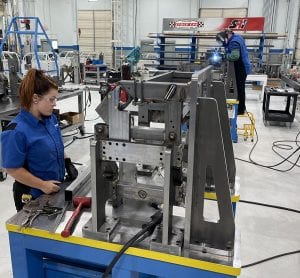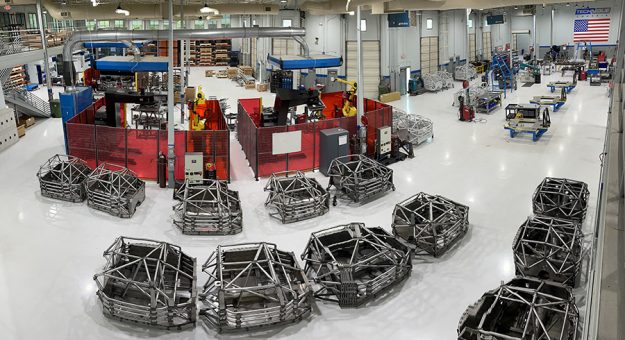When next year’s NASCAR Cup Series campaign kicks off at Daytona Int’l Speedway in February, all of the competing cars will have been built at the same place — Technique Chassis in Concord, N.C.
With the rollout of the Next Gen race cars, Technique is one of the approved suppliers that teams will rely on to prepare the race cars. Technique is building front clips, rear clips and center sections for all of the chassis used in the Next Gen cars.
Owned by former open-wheel racer Ronnie Johncox, Technique Chassis is an offshoot of Technique, Inc., the Jackson, Mich.-based company that Johncox opened in 1991.
Technique, Inc. specializes in stamping, welding and tubing for automotive, heavy truck, agriculture, rail car, military and other applications and has been building center sections for the current NASCAR chassis for several years.
Technique Chassis was formed in 2020 and moved into the former Roush Fenway Racing shop that housed cars driven by Mark Martin in March of last year.
With a staff of 27 employees, most of whom previously worked for NASCAR teams, Technique Chassis was scheduled to deliver the first 40 Next Gen chassis to NASCAR on June 15 at which point sanctioning body officials would distribute them to the individual teams. Technique is expected to provide 280 cars prior to next February. Each completed chassis sells for $25,000.
The Next Gen cars were designed by Dallara and NASCAR, and Technique is building them to that design. All chassis are within one pound of tolerance of one another, ensuring consistency and repeatability.
One reason for the consistency in the manufacturing process is Technique’s use of augmented automation. That means is robots and humans are utilized in the production process.

“A robot doesn’t care if it makes a good weld or not, so we have to be very selective with what is a good application for robotic welding and you augment that with the skilled, experienced racing technicians that have been building cars for years,” Johncox explained.
“A lot of the guys who work here are master craftsman,” he continued. “They are world-class, so they are naturally skeptical. They think, ‘Oh, the robot is going to take jobs away.’ But the robot doesn’t take jobs away, it changes the skillset that needs to be mastered.
“Initially, we had the automated side and the manual side and there was this wall, and you have to educate everybody on the benefits of both and why we have to have both. One without the other will not be successful in this concept.”
According to Johncox, the initial goal was for the job to be split 50-50 between robots and Technique’s staff, but he claims they have exceeded that expectation.
“On the center section, it is about 60 percent robotic and 40 percent manual,” Johncox said. “The front of the car is 90 percent robotic and 10 percent manual and the rear clip is 70 percent robotic and 30 percent manual.”
Johncox believes the innovation of the racers working in Technique’s shop is the root of that efficiency.
“The natural innovation that racers have has taken this to the next level,” he noted. “I expected it to be like this, but it has exceeded my expectations by how fast they have adapted to this and developed along to it. All these guys, with the exception of one, have come from other teams.”
In most cases, experienced welders have been trained to operate the robotic welders.
“We can train them in- house,” Johncox said. “If you are open-minded and willing to embrace the tool for what it is, the sky is the limit.
“We are doing more with these robots. We are ahead of Lincoln in terms of our integration and because these guys know how to weld, they have taken robotic welding to a whole different level.”
Johncox says the company is approaching $10 million in investment for the project, which includes $5 million for the facility and building and several robotic Lincoln Welders valued at approximately $600,000 each.
The shop is currently 37,000 square feet, but a 24,000-square-foot addition that will house the repair and maintenance portion of the program is on the way.
While it is the first time every NASCAR Cup Series car has been built to exactly the same specs by the same builder, there are some interesting aspects of the Technique Chassis.
Every front, rear and center section includes its own QR code, which teams can scan to learn vital information about that piece.
“Every front, center and rear has a unique serial number and a unique QR code,” Johncox said. “NASCAR has all the data on every single piece that we make. We have all of that data. When a team is issued a serial number, they will have log-in credentials and will have access to their chassis and data.
“When that piece comes back to us, we can measure it in the crashed state and compare that to the dimensions from what it was when it left here. We will know numerically how far from spec it is.”
